
BUSINESS
Kforce Inc. provides professional staffing services and solutions in the United States. It operates through two segments, Technology, and Finance and Accounting (FA). The Technology segment provides talent solutions to its clients primarily in the areas of information technology, such as systems/applications architecture and development, data management and analytics, business and artificial intelligence, machine learning, project and program management, and network architecture and security. This segment serves clients in various industries comprising financial and business services, communications, insurance, retail, and technology industries. The FA businesses segment offers talent solutions to its clients in areas, including financial planning and analysis, business intelligence analysis, accounting, transactional accounting, business and cost analysis, and taxation and treasury.

INVESTMENT RATING
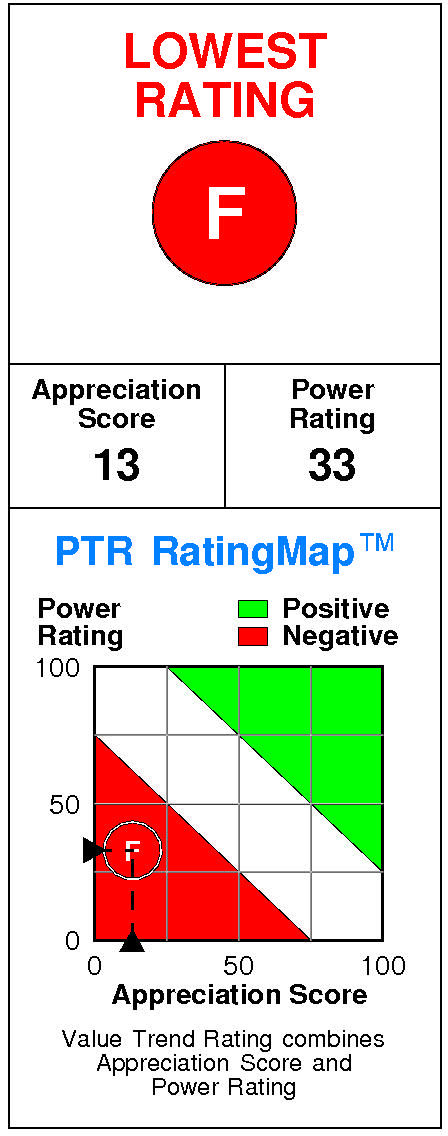
Reflecting future returns on capital that are forecasted to be above the cost of capital, KFRC is expected to continue to be a major Value Builder.
Kforce has a current Value Trend Rating of F (Lowest Rating).
With this rating, PTR's two proprietary measures of a stock's current attractiveness are providing complementary signals. Kforce has a slightly negative Power Rating of 33 and a very low Appreciation Score of 13, producing the Lowest Value Trend Rating.
Kforce's stock is selling significantly above targeted value.
The current stock price of $62.12 compares to targeted value 12 months forward of $28.
Kforce's very low appreciation potential results in an appreciation score of 13 (87% of the universe has greater appreciation potential.)
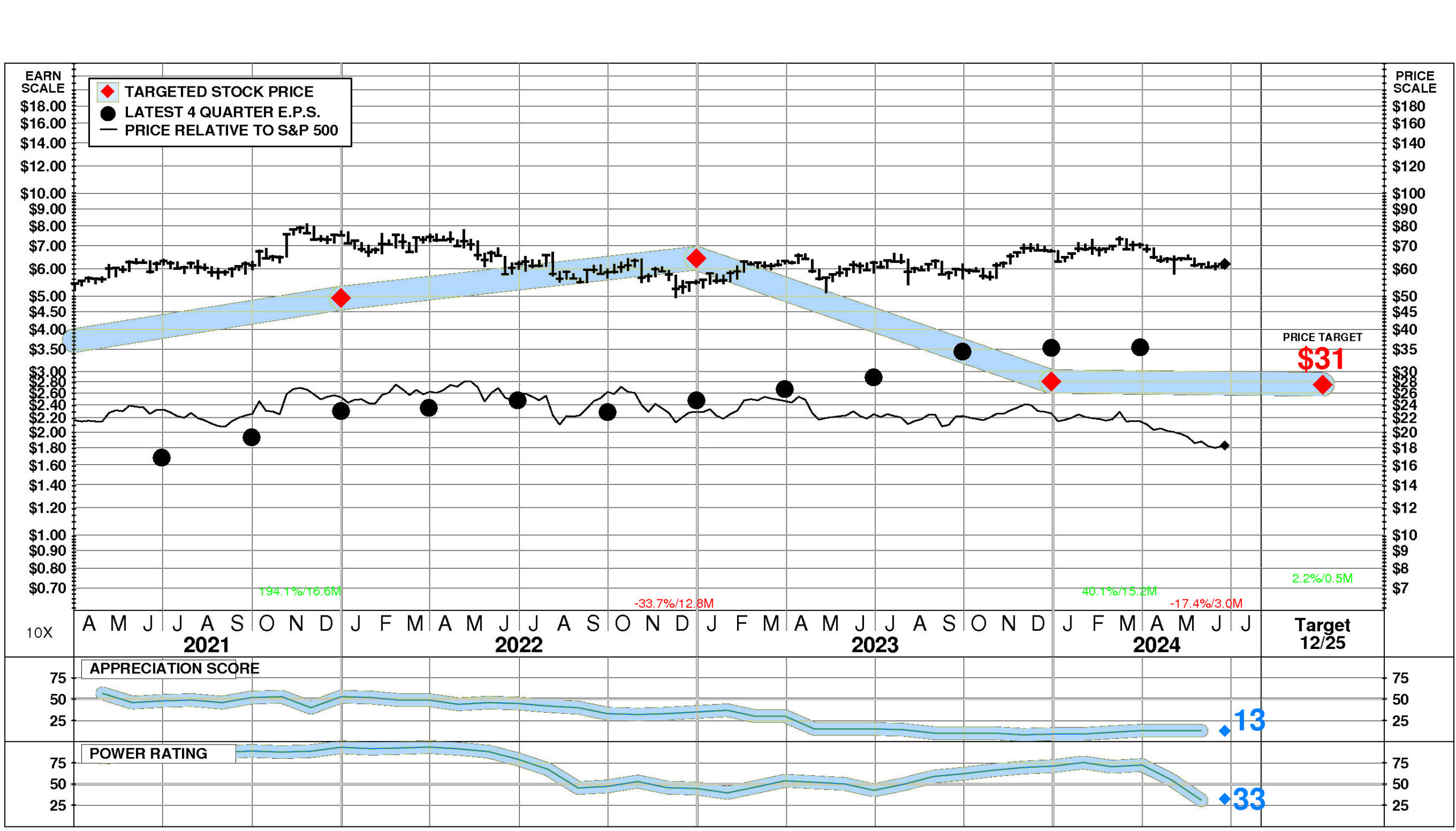
Kforce has a Power Rating of 33.
(Kforce's slightly negative Power Rating indicates that it only has a higher likelihood of achieving favorable investment performance over the near to intermediate term than 33% of companies in the universe.)
Factors contributing to this slightly negative Power Rating include: the Help Supply Services comparison group is currently in an unfavorable position; earnings estimate behavior for Kforce has been slightly negative recently; and recent price action has been neutral.
INVESTMENT PROFILE
Kforce's financial strength is high. Financial strength rating is 87.
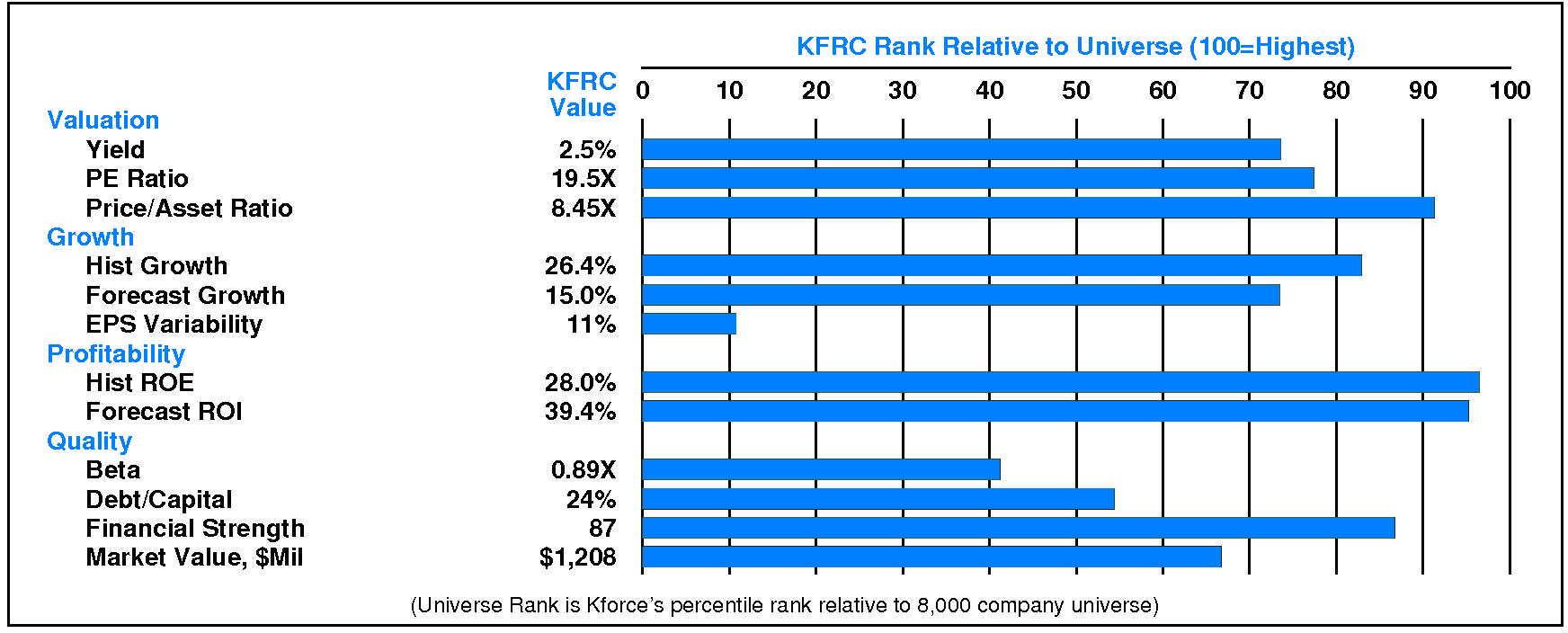
Relative to the S&P 500 Composite, Kforce Inc has significant Growth characteristics; its appeal is likely to be to investors neutral towards Income; the perception is that KFRC is lower risk.
All factors are relative strengths. Kforce's valuation is moderate: moderate dividend yield, moderate P/E ratio, and high price/book ratio. KFRC has unusually low market capitalization.
CURRENT SIGNALS
Kforce's current operations are eroding.
Return on equity is falling, reflecting: falling asset utilization; declining pretax margin; and falling leverage.
Kforce's current technical position is mixed.
The stock price is in a 3.0 month down move. The stock has declined 14.8% from its prior high. The 200 day moving average is in an uptrend. The stock price is below its 200 day moving average.
ALERTS
Kforce Inc (NYSE: KFRC) has recently experienced slight negative changes in fundamentals: significant quarterly sales deceleration occurred.
The stock is currently rated F.
On 6/24/24, Kforce Inc (NYSE: KFRC) stock rose slightly by 0.2%, closing at $62.12. Trading volume in this advance was normal. The stock has performed in line with the market over the last nine months and is unchanged during the last week.
CASH FLOW
In 2023, Kforce experienced no change in cash of $0.00 million (-2%). Sources of cash balanced uses.
Cash generated from 2023 EBITDA totaled +$97.97 million. Non-operating uses consumed -$6.59 million (-7% of EBITDA). Cash taxes consumed -$24.17 million (-25% of EBITDA). Withdrawal of investment from the business totaled +$7.20 million (+7% of EBITDA). On a net basis, debt investors provided +$9.79 million (+10% of EBITDA) while equity investors received -$84.19 million (-86% of EBITDA).
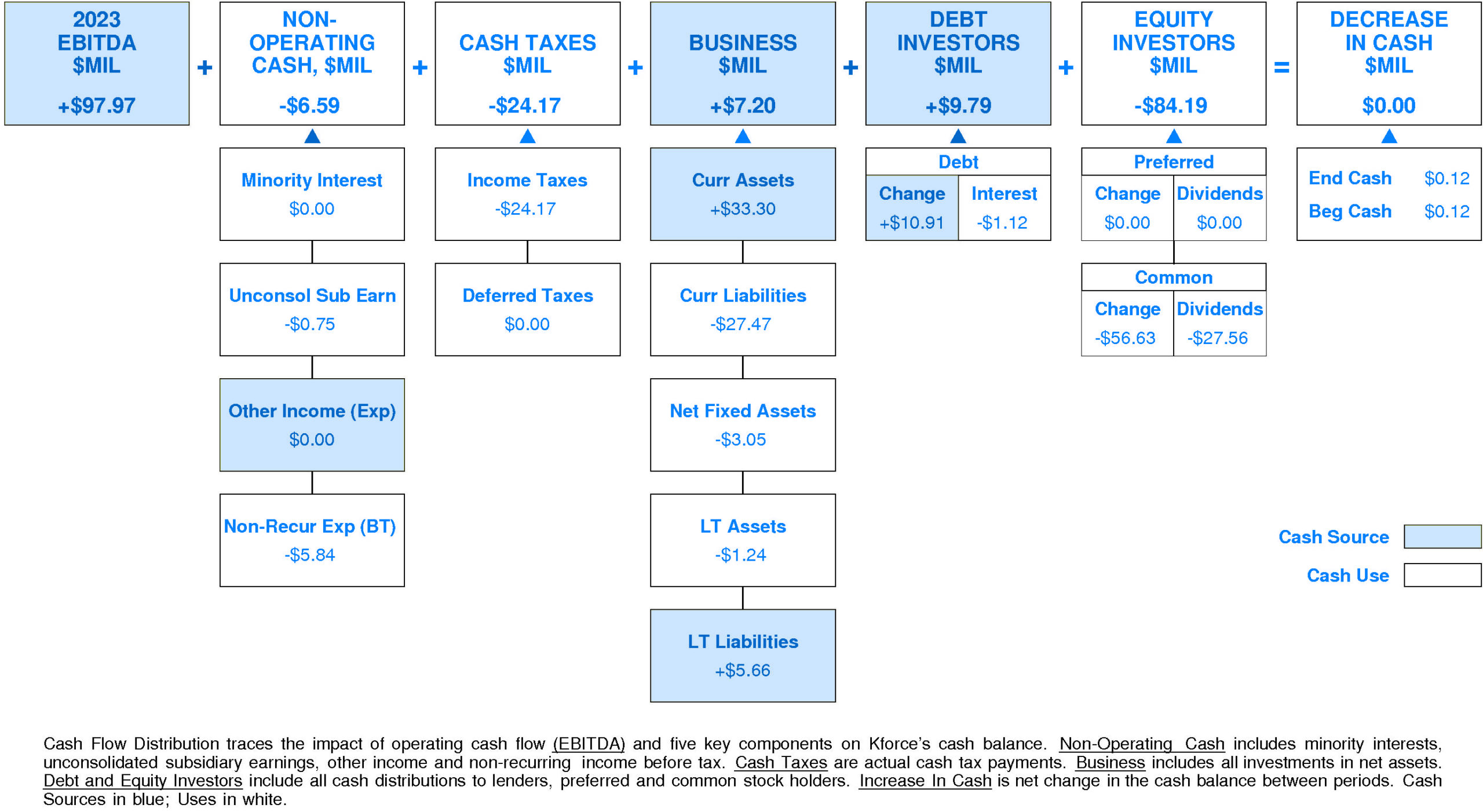
Kforce's Non-operating Income, %EBITDA has experienced a downtrend over the period.
This downtrend was accompanied by stability for the Kforce Peer Group. In most years, Kforce was in the third quartile and top quartile. Currently, Kforce is slightly below median at -7% of EBITDA (-$6.59 million).
Kforce's Cash Taxes, %EBITDA has exhibited a minor overall uptrend over the period.
This improvement was accompanied by a similar trend for the Kforce Peer Group. (Since 2021 Cash Taxes, %EBITDA has experienced a minor decline.) In most years, Kforce was in the third quartile and lower quartile. Currently, Kforce is below median at -25% of EBITDA (-$24.17 million).
Kforce's Business Re-investment, %EBITDA has enjoyed a volatile overall uptrend over the period.
This improvement was accompanied by a similar trend for the Kforce Peer Group. In most years, Kforce was in the second quartile and top quartile. Currently, Kforce is at median at +7% of EBITDA (+$7.20 million).
Kforce's Debt Investors, %EBITDA has experienced a volatile overall downtrend over the period.
This downtrend was accompanied by stability for the Kforce Peer Group. In most years, Kforce was in the top quartile and lower quartile. Currently, Kforce is at the upper quartile at +10% of EBITDA (+$9.79 million).
Kforce's Equity Investors, %EBITDA has experienced a downtrend over the period.
This downtrend was accompanied by a similar trend for the Kforce Peer Group. (Since 2020 Equity Investors, %EBITDA has accelerated sharply.) In most years, Kforce was in the third quartile and lower quartile. Currently, Kforce is lower quartile at -86% of EBITDA (-$84.19 million).
Kforce's Change in Cash, %EBITDA has experienced a downtrend over the period.
This downtrend was accompanied by an opposite trend for the Kforce Peer Group. In most years, Kforce was in the third quartile and second quartile. Currently, Kforce is substantially below median at 0% of EBITDA ( $0.00 million).
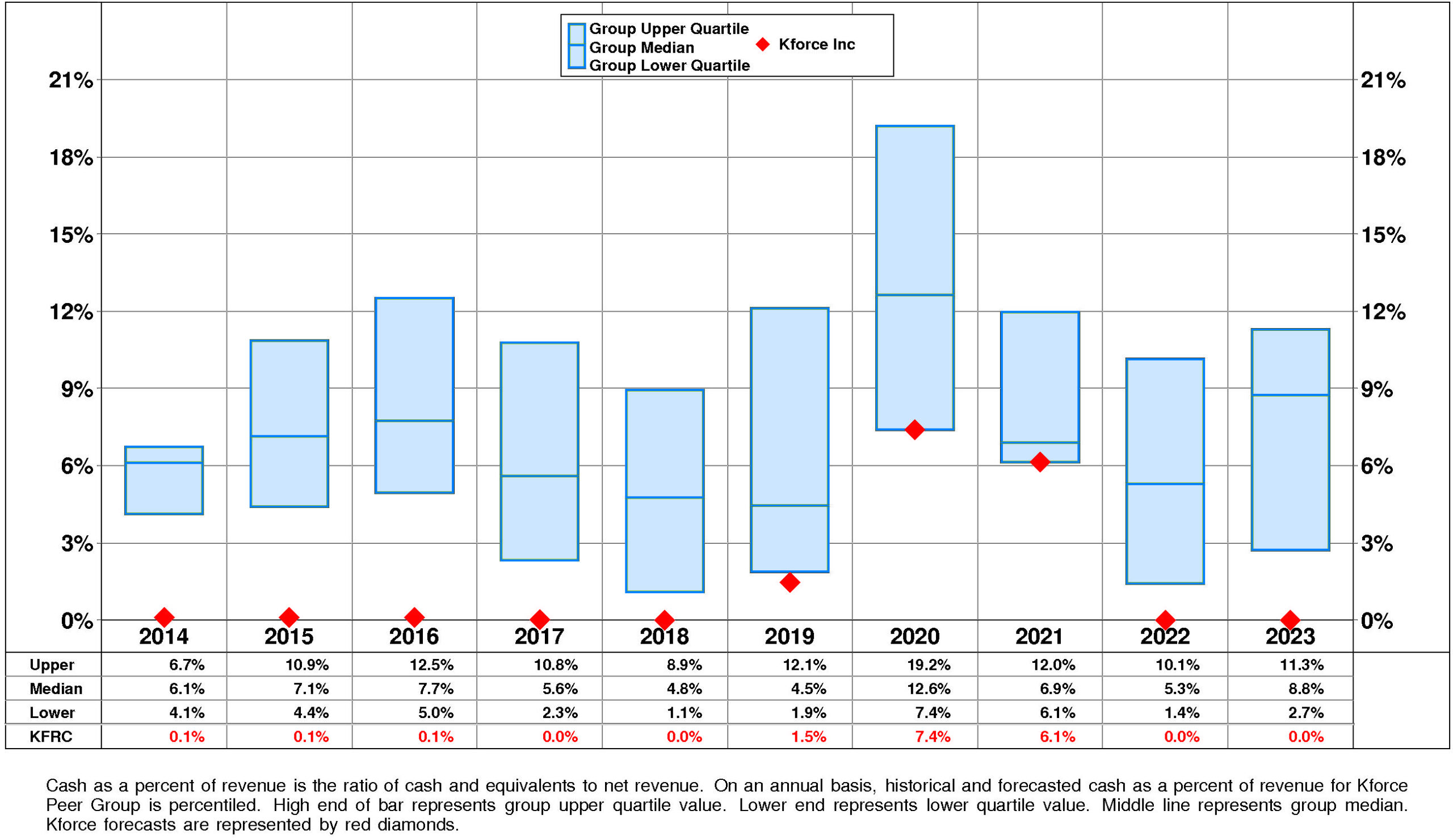
Kforce's Cash, %Revenue has exhibited little to no overall change over the period.
This stability was accompanied by stability for the Kforce Peer Group as well. (Since 2020 Cash, %Revenue has experienced a sharp decline.) In most years, Kforce was in the lower quartile. Currently, Kforce is lower quartile at 0%.
PROFITABILITY
Kforce's return on equity has improved very significantly since 2014. The current level of 34.0% is 1.61X the low for the period and is -1.4% from the high.
This very significant improvement was due to very strong positive trend in pretax operating return and little change in non-operating factors.
The productivity of Kforce's assets rose over the full period 2014-2024: asset turnover has exhibited a volatile overall uptrend that sharply accelerated after the 2020 level.
Reinforcing this trend, pretax margin enjoyed a strong overall uptrend but it experienced a very sharp decline after the 2021 high.
Non-operating factors (income taxes and financial leverage) had little influence on return on equity.
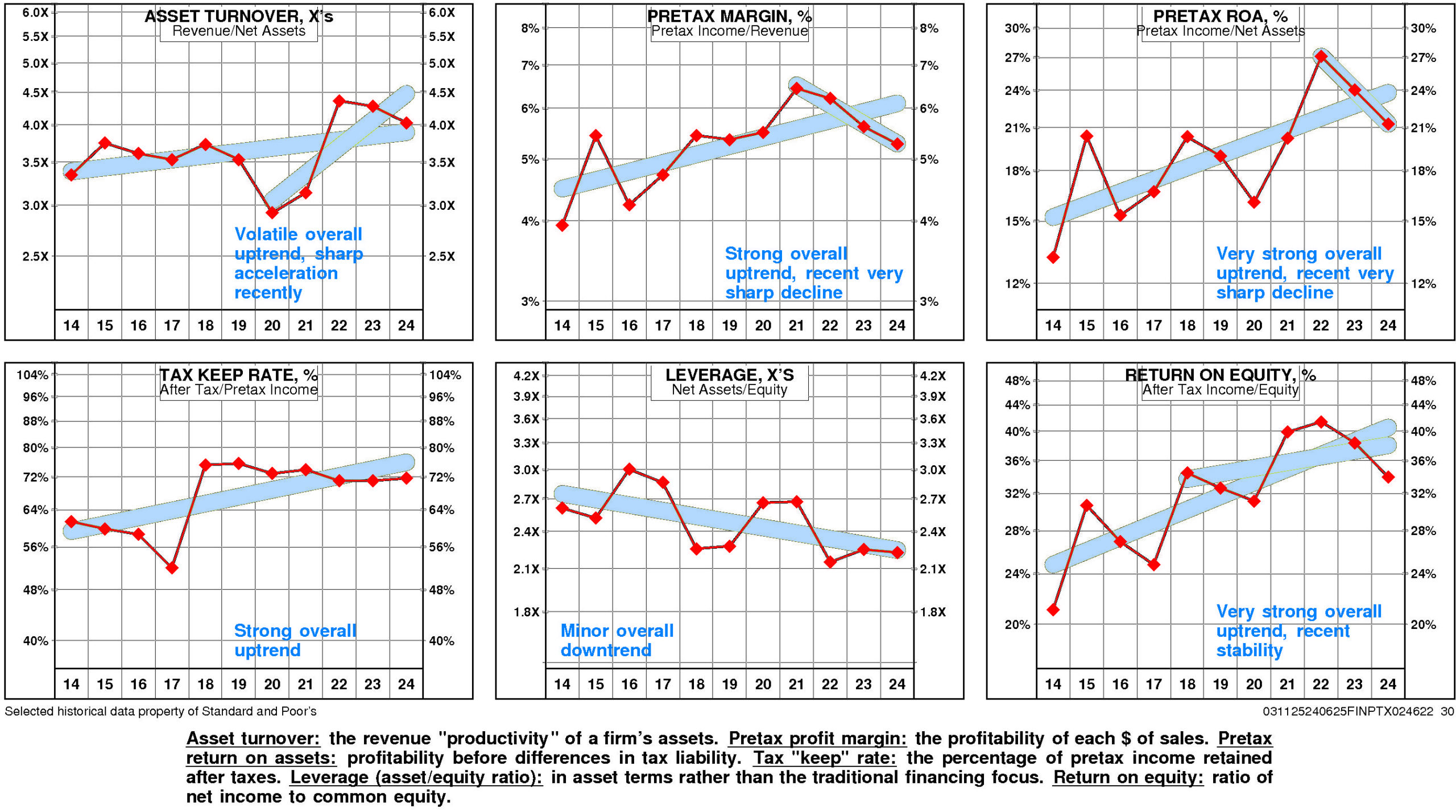
Kforce's return on equity is above median (34.0%) for the four quarters ended March, 2024.
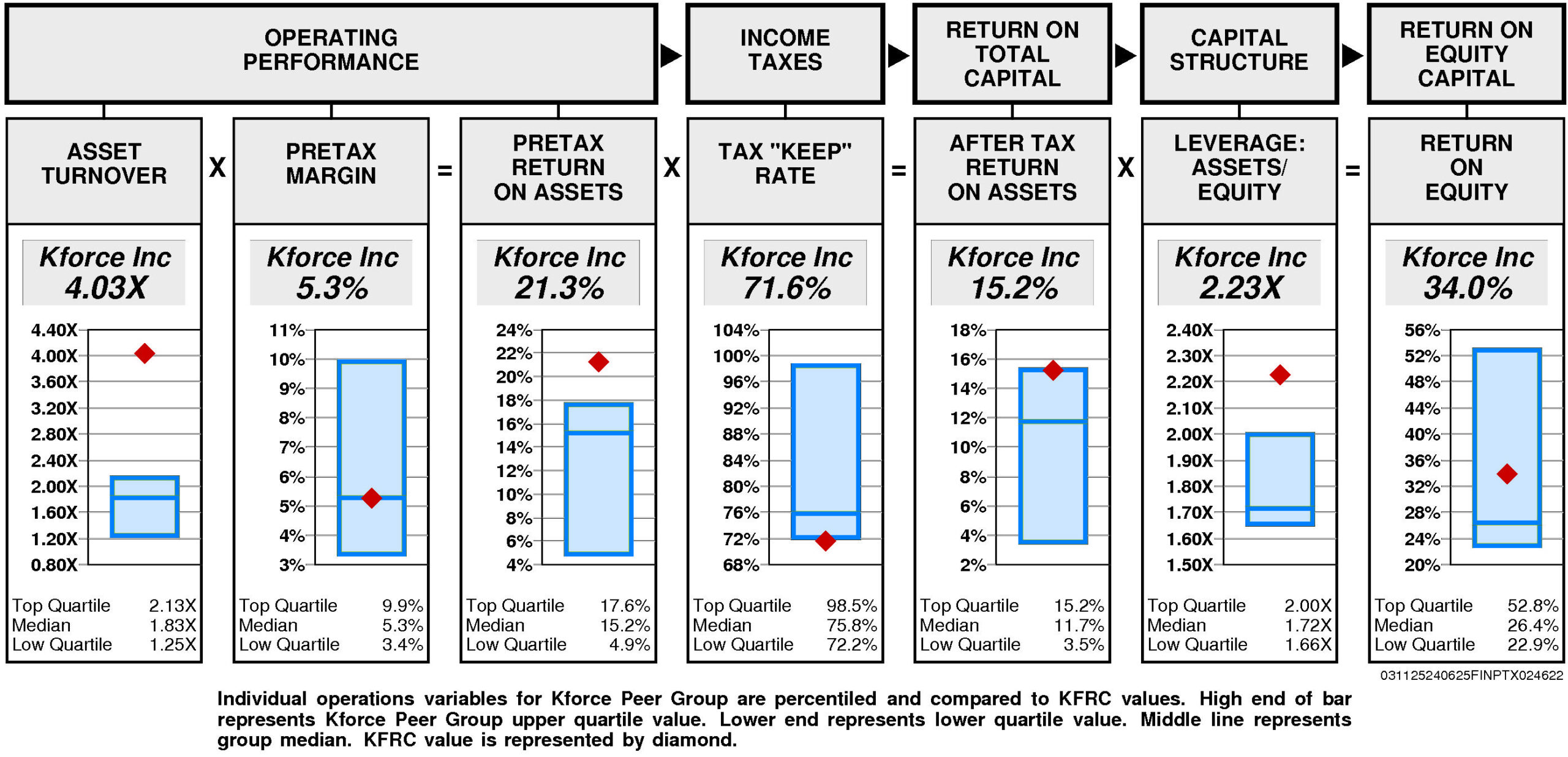
Operating performance (pretax return on assets) is upper quartile (21.3%) reflecting asset turnover that is upper quartile (4.03X) and at median pretax margin (5.3%).
Tax “keep” rate (income tax management) is at the lower quartile (71.6%) resulting in after tax return on assets that is at the upper quartile.
Financial leverage (leverage) is upper quartile (2.23X).
GROWTH RATES
Overall, Kforce's growth rate has slowed very considerably in recent years.
Kforce's historical income statement growth and balance sheet growth have diverged. Revenue growth has paralleled asset growth; earnings growth has exceeded equity growth.
Annual revenue growth
has been 7.0% per year.
Total asset growth
has been 5.5% per year. (More recently it has been -9.4%.)
Annual E.P.S. growth
has been 13.6% per year. (More recently it has been -8.3%.)
Equity growth
has been 7.6% per year. (More recently it has been -4.7%.)
Kforce's consensus growth rate forecast (average of Wall Street analysts)
is 15.0% — substantially above the average of the historical growth measures.
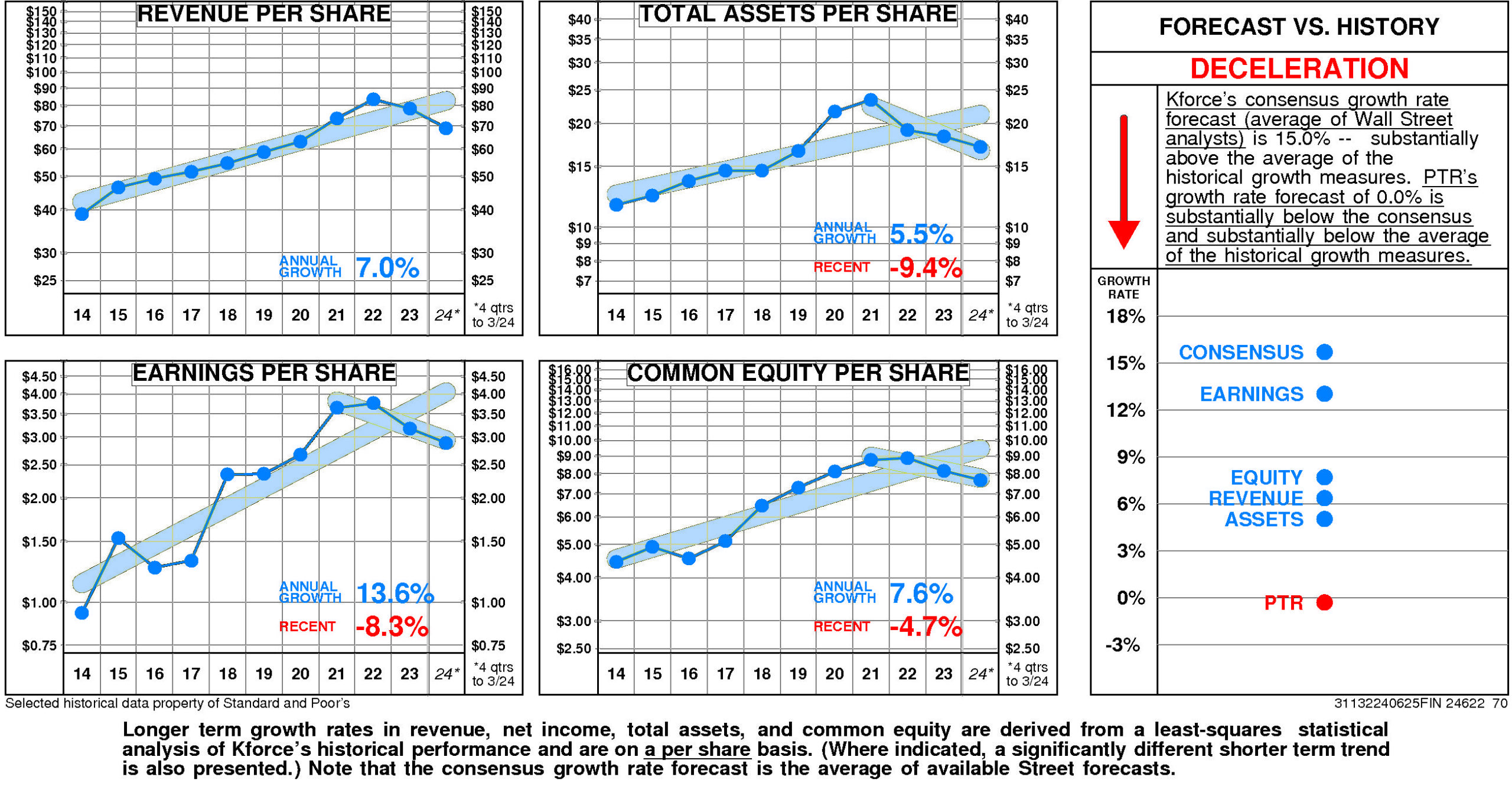
Relative to the Kforce Peer Group, Kforce's historical growth measures are generally third quartile.
Revenue growth (7.0%) has been at median. E.P.S. growth (13.6%) has been below median. Equity growth (7.6%) has been at the lower quartile. Total asset growth (5.5%) has been at the lower quartile.
In contrast, consensus growth forecast (15.0%) is upper quartile.
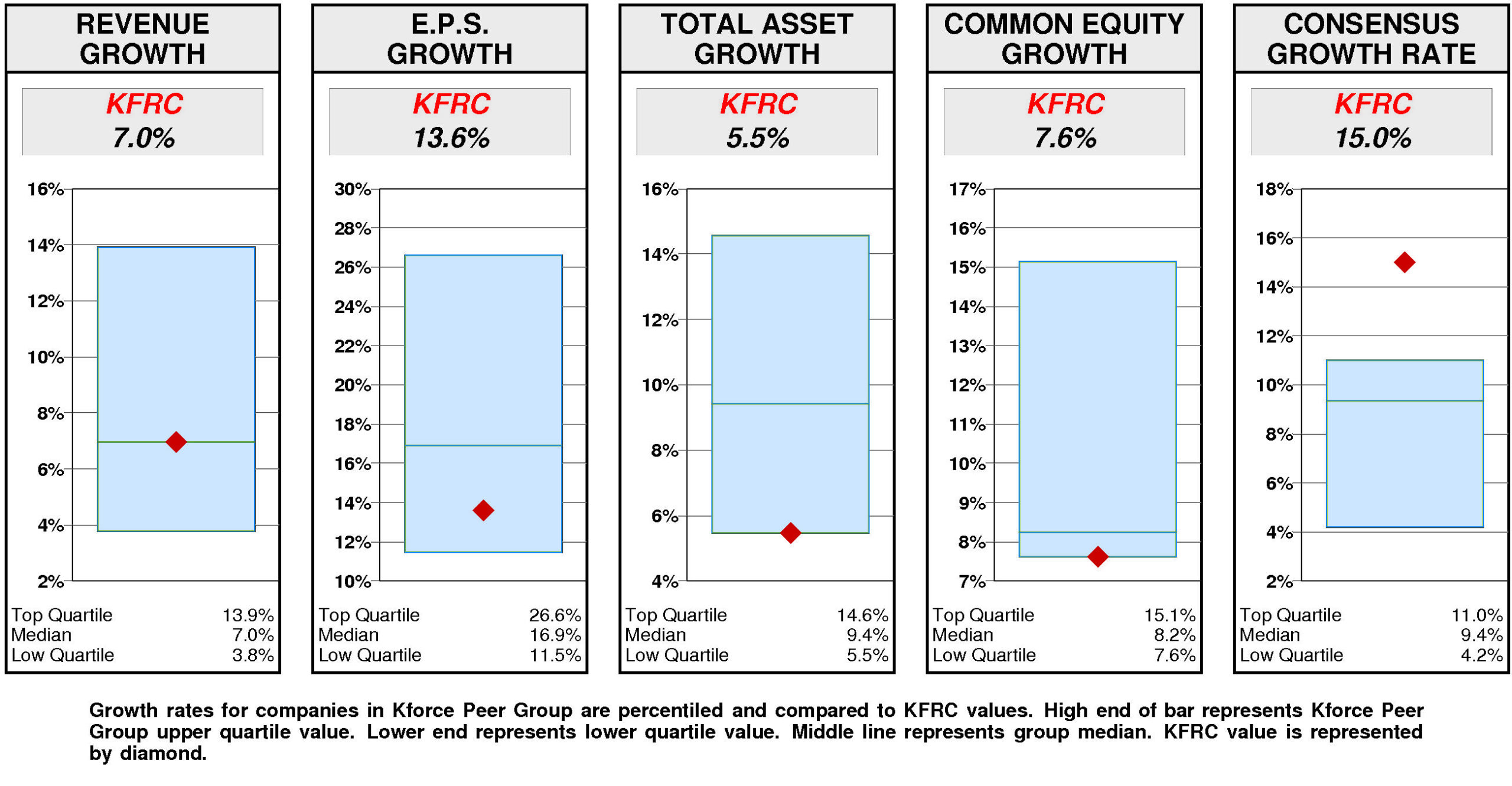
PRICE HISTORY
Over the full time period, Kforce's stock price performance has been variable and good.
Between August, 2013 and June, 2024, Kforce's stock price rose +282%; relative to the market, this was a +14% gain. Significant price moves during the period: 1) March, 2020 – November, 2021: +200%; and 2) May, 2017 – August, 2018: +134%.
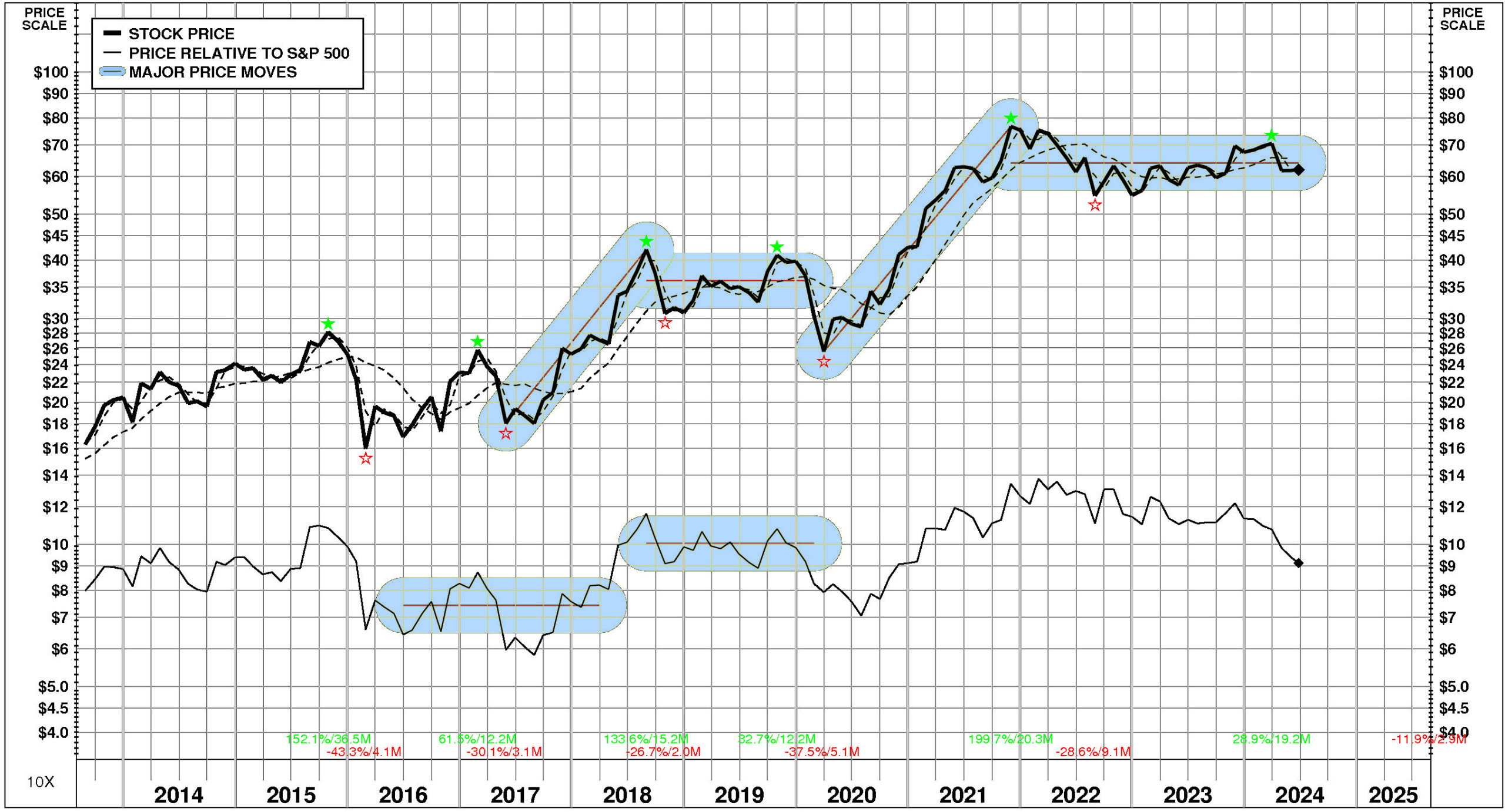
TOTAL INVESTMENT RETURNS
Current annual total return performance of 9.8% is below median relative to the S&P 500 Composite.
In addition to being below median relative to S&P 500 Composite, current annual total return performance through May, 2024 of 9.8% is slightly above median relative to Kforce Inc Peer Group.
Current 5-year total return performance of 14.5% is above median relative to the S&P 500 Composite.
Through May, 2024, with above median current 5-year total return of 14.5% relative to S&P 500 Composite, Kforce's total return performance is at median relative to Kforce Inc Peer Group.

VALUATION BENCHMARKS
Relative to S&P 500 Composite, KFRC's overall valuation is normal.
The highest factor, the price/equity ratio, is upper quartile. Ratio of enterprise value/assets is upper quartile. Price/earnings ratio is slightly below median. Ratio of enterprise value/earnings before interest and taxes is near the lower quartile. The lowest factor, the ratio of enterprise value/revenue, is lower quartile.
Relative to Kforce Peer Group, KFRC's overall valuation is normal.
The highest factor, the ratio of enterprise value/assets, is near the upper quartile. Price/equity ratio is upper quartile. Ratio of enterprise value/revenue is at median. Price/earnings ratio is at median. The lowest factor, the ratio of enterprise value/earnings before interest and taxes, is slightly below median.
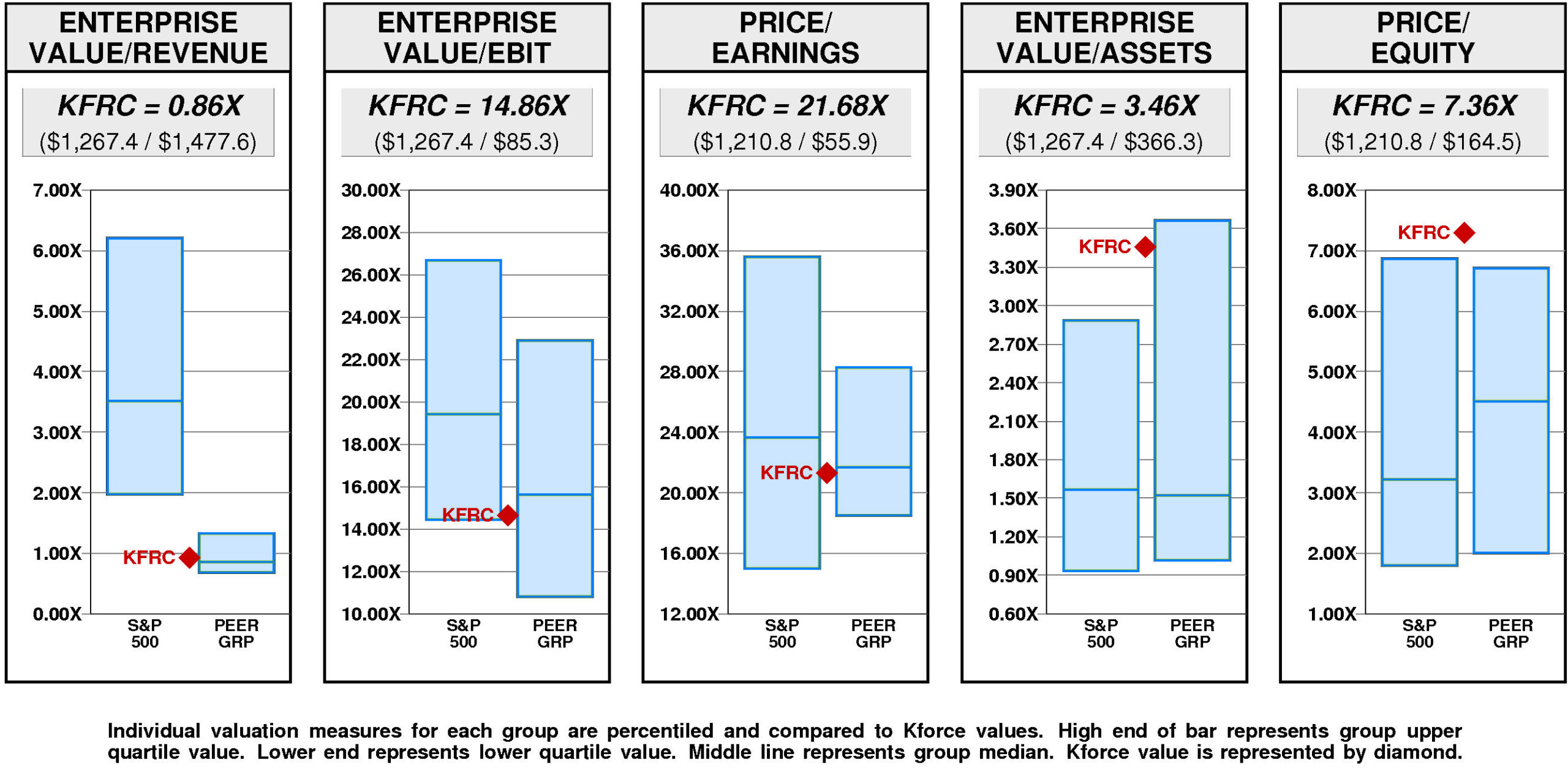
Kforce has a very large value gap compared to median valuation.
For KFRC to fall to lower quartile valuation, its current ratio of enterprise value/revenue would have to decline from the current level of 0.86X to 0.68X. If KFRC's ratio of enterprise value/revenue were to decline to 0.68X, its stock price would be lower by $-13 to $49.
For KFRC to achieve upper quartile valuation relative to the Kforce Peer Group, its current ratio of enterprise value/revenue would have to rise from the current level of 0.86X to 1.33X. If KFRC's ratio of enterprise value/revenue were to rise to 1.33X, its stock price would increase by $36 from the current level of $62.
VALUE TARGETS
Reflecting future returns on capital that are forecasted to be above the cost of capital, KFRC is expected to continue to be a major Value Builder.
Kforce's current Price Target of $32 represents a -50% change from the current price of $64.00.
Kforce's very low appreciation potential results in an appreciation score of 13 (87% of the universe has greater appreciation potential.)
Reinforcing this low Appreciation Score of 13, the moderately low Power Rating of 33 contributes to an Value Trend Rating of F.
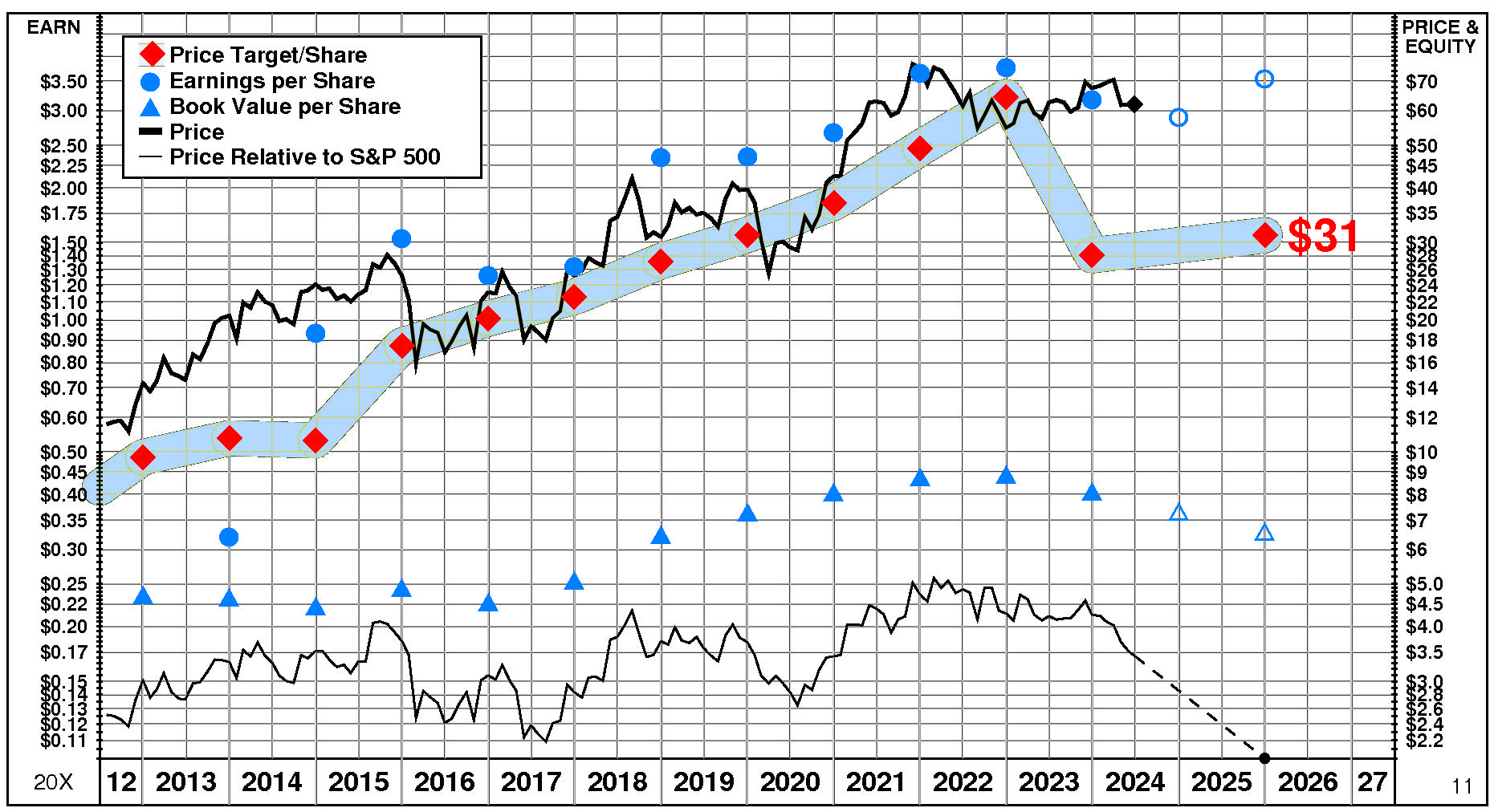
Kforce's current Price Target is $32 (+14% from the 2023 Target of $28 but -50% from the 05/03/24 price of $64.00).
This slight rise in the Target is the result of a -14% decrease in the equity base and a +33% increase in the price/equity multiple. One Driver has a positive impact on the price/equity multiple, one has a negative impact, and one has no effect. The forecasted increase in return on equity has a very large positive impact on the price/equity multiple. The forecasted growth has no impact. The forecasted increase in cost of equity has no negative impact.
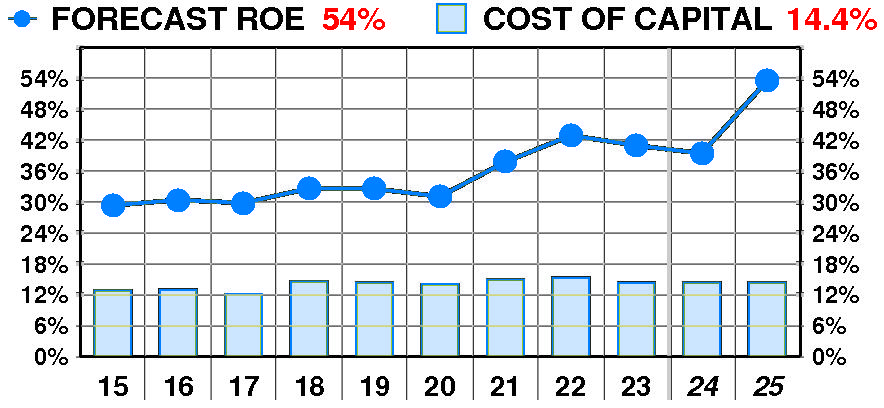
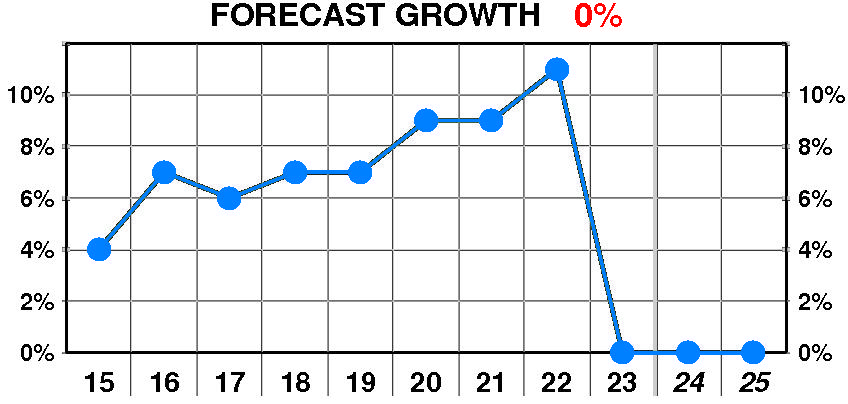
PTR's return on equity forecast is 54.6% — substantially above our recent forecasts.
Forecasted return on equity enjoyed a dramatic, variable increase between 2015 and 2023. The current forecast is significantly above the 2015 low of 29%.
PTR's growth forecast is 0.0% — in line with our recent forecasts.
Forecasted growth enjoyed a dramatic, steady increase between 2015 and 2023. The current forecast is significantly below the 2022 peak of 11%.
PTR's cost of equity forecast is 14.3% — in line with recent levels.
Forecasted cost of equity suffered a dramatic, erratic increase between 2015 and 2023. The current forecast is above the 2017 low of 12.2%.

At Kforce's current price of $64.00, investors are placing a positive value of $10 on its future investments. This view is consistent with the company's most recent performance that reflected a growth rate of 0.0% per year, and a return on equity of 41.0% versus a cost of equity of 14.3%.
PTR's 2025 Price Target of $32 is based on these forecasts and reflects an estimated value of existing assets of $51 and a value of future investments of $-19.

















